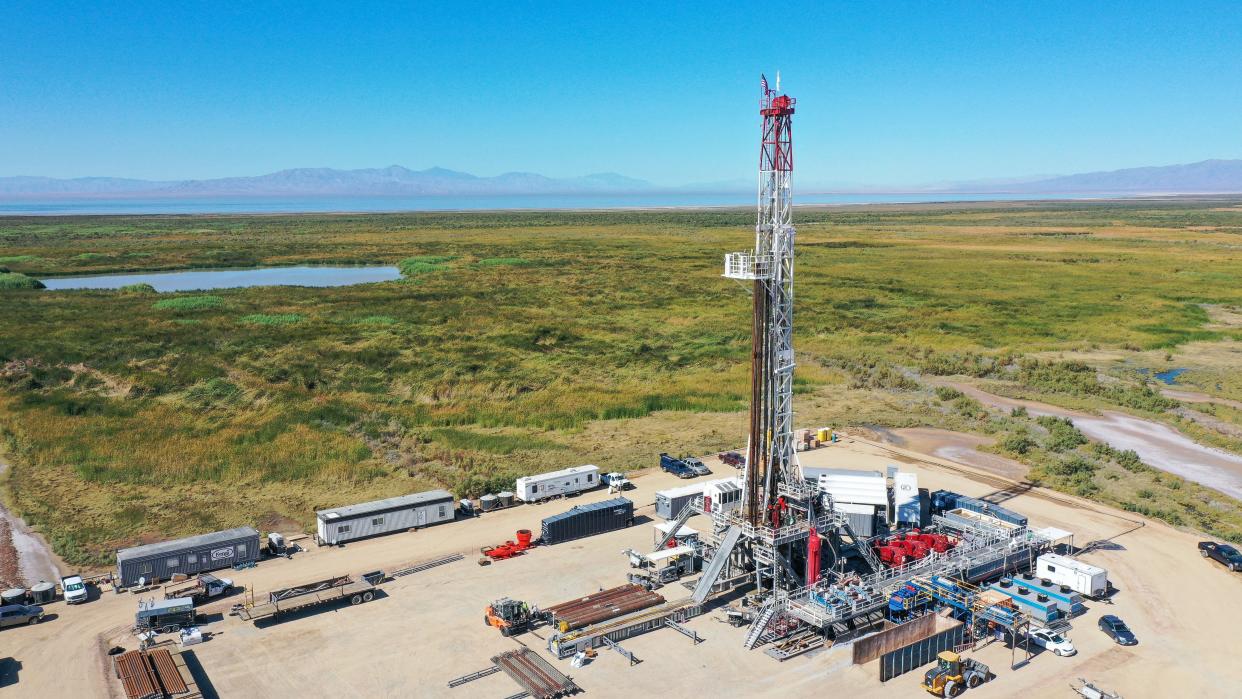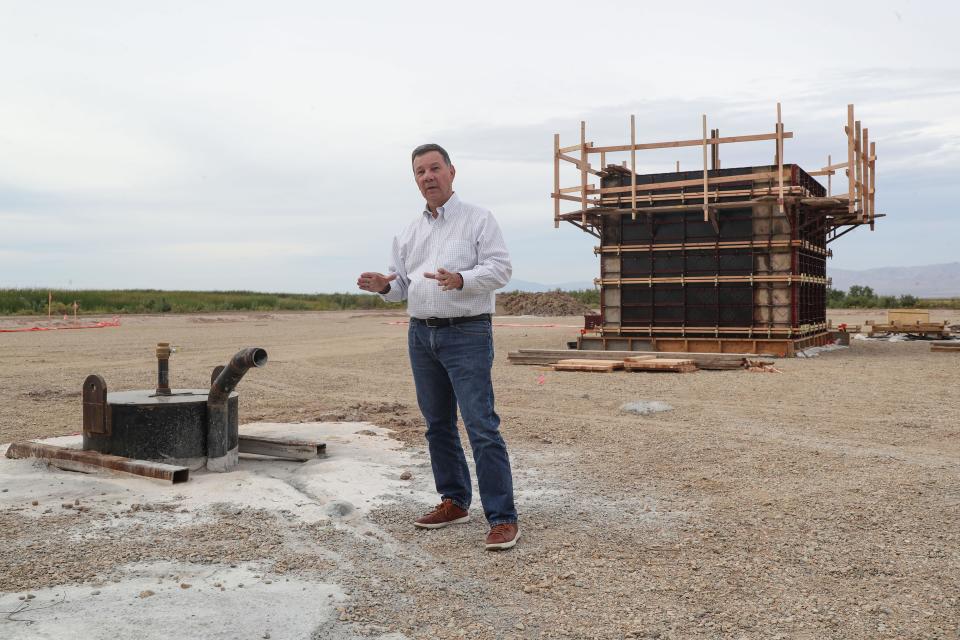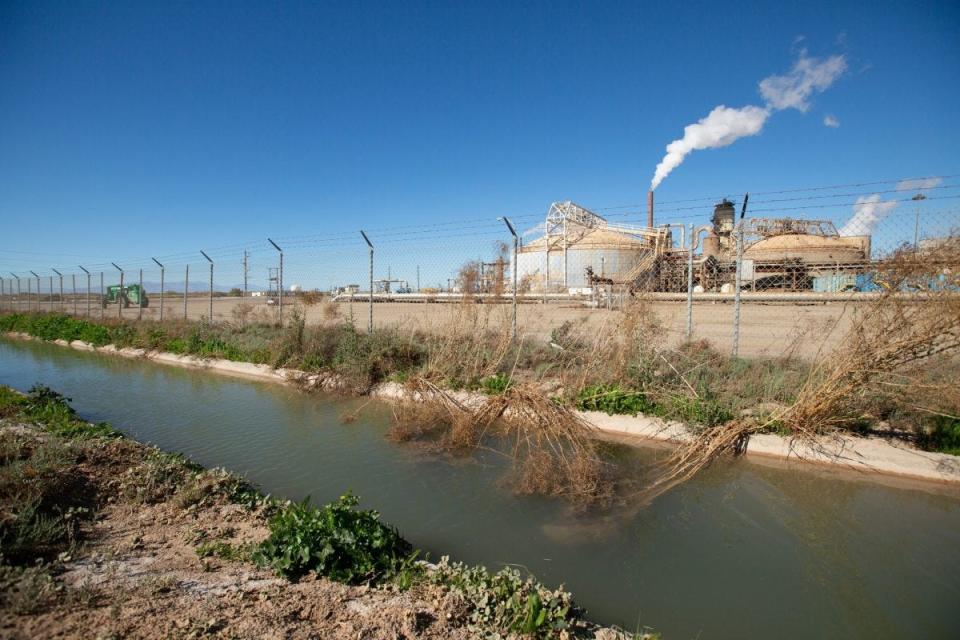Lithium Valley: A look at the major players near the Salton Sea seeking billions in funding

Imperial Valley has a new nickname these days: Lithium Valley. Or as California Gov. Gavin Newsom likes to call it, “the Saudi Arabia of lithium.”
The monikers are a nod to vast reserves of the white-hot mineral deep below the Earth’s surface in California's hot, southeast corner, near the Salton Sea. While likely one of the world's largest lithium deposits, it will be at least two years before major tonnage will be produced.
But because lithium is a main ingredient in electric vehicle and power grid batteries, and will be jointly produced with clean geothermal steam power, the pressure in on as the United States, California and others ratchet up clean energy mandates, and as potential profits grow.
With China in particular ramping up electric vehicle production and sales, prices there soared to an estimated $450,000 for a ton of finished lithium in late April, more than double a previous high at the end of January, according to Brad Franklin, a Riverside-based economist for The Nature Conservancy. Prices for lithium carbonate and lithium hydroxide — the compounds likely to be produced in Lithium Valley, have also spiked to record highs.
Three companies, Controlled Thermal Resources, EnergySource and Berkshire Hathaway Renewables, are testing or scaling up pilot technologies at the Salton Sea, running the gauntlet of environmental approvals and permits, and seeking billions of dollars in private and public funding for construction of up to half a dozen facilities in the next decade.
Gov. Newsom on Friday proposed major grants, loans and infrastructure funds to help developers and county officials speed up pilot tests, approvals and construction, and to educate a skilled workforce and build vital transmission lines.
Developing quickly is "extremely, extremely essential, the market demand for lithium is absolutely outrageous. I mean, it is huge market demand," said Jim Turner, chief operations officer for Controlled Thermal Resources, an Australian energy company. "If it's supply out of the Salton Sea, regardless of whether it's Energy Source, or Berkshire or us, that means that's the less lithium that the automakers are going to go overseas to get."
Prices have plateaued in recent weeks, but with limited global supplies and surging demand, they will likely stay high for some time.
“The lithium market is very dynamic, it's changing constantly, but in general, the skyrocketing prices right now are giving everybody a big incentive to get their projects up and running,” Franklin said.
But he and other experts believe it is critical to examine potential environmental impacts as well as benefits.
Vast underground reserve
Lithium, the lightest known metal on Earth, is capable of holding an electric charge for long periods, and has emerged as a critical ingredient not just in EV batteries, but in smart phones and large grid storage. Worldwide, lithium production increased in 2021 by 21% to approximately 100,000 tons, according to the U.S. Geological Survey, in response to strong demand for lithium ion batteries and rising prices. State energy researchers say ultimately a third of global supply could come from Lithium Valley — or more precisely, what lies underground.
For decades, a raw form of lithium was considered part of the waste stream from a 10-square-mile stretch of large power plants atop a massive underground brine pool likely twice that size, known as the Salton Sea Geothermal Reserve, about 90 miles south of Palm Springs. The plants produce largely toxic-free power by extracting huge amounts of superheated brine from more than a mile underground that “flashes” into steam when it is brought to the surface. Along with other trace minerals, lithium salts, which can form pipe clogging deposits similar to white crust from hard tap water, were filtered out and discarded.
“It was worth so little, we used to just inject it back into the ground,” said Turner with CT Resources, who in previous roles for other companies oversaw the construction and operation of several of the Imperial Valley's geothermal power plants.
Getting it done
The key piece of the Lithium Valley puzzle has been figuring out how to extract the lithium from this geothermal brine at commercial scale.
Separating that metal and others with potential market value from the brine is less invasive than blasting and other hard rock mining done in Australia, or huge, open air evaporation pounds in South America. But it's not easy.
"The traditional ways of mining lithium are really destructive and really hard on the environment for local communities, and so the attraction of geothermal lithium is that the footprint is small," UC Riverside geochemist Michael McKibben said. "You're not digging pits, you're not putting huge evaporation ponds on the surface, because the brine is already brought up for the steam, so it's just a matter of tacking on a lithium filter to that brine before you reinject it back into the ground."
Industry representatives say it's more complicated than simply adding a filter, though that is a key piece. And environmentalists and public health experts say dust, and emissions from trucks traveling to and from the site, could worsen existing health issues, and full health impact analyses should be done for all projects.
McKibben and other scientists are working on a new study led by Lawrence Berkeley National Laboratory to map lithium deposits, extraction and potential consequences.
McKibben said he understands the concerns over potential impacts like truck traffic.
"Nothing is going to be completely clean," he said. "But this is the cleanest way we can do it, using geothermal."
CT Resources and the other companies are hoping to capitalize on the opportunity to extract lithium in a cleaner way. They're pressing forward with projects to extract, soften and refine the soft, whitish metal into a usable form for battery manufacturers. They’ve hired specialty firms to scale up successful pilot production methods and are seeking partners and funds — both private and public — for what could ultimately be a huge development zone.
EnergySource eyes construction this summer
The company closest to the starting line is EnergySource, which could begin construction of the nation's first commercial-scale brine to lithium plant this summer. The San Diego-based company received the necessary approvals from the Imperial County Planning Commission for Project ATLiS in November, marking a first for a full processing plant beyond a pilot or demonstration-scale project.
“We are highly, highly confident (in the project’s commercial viability). We have piloted this, we know that it works, and that it works economically, and we would like this to be the first brine-based lithium extraction facility in the U.S.,” EnergySource President and CEO Eric Spomer told The Desert Sun.
Now that EnergySource has a conditional use permit from the county, the company just has a few “contractual hurdles” to address before potentially starting construction this summer “if everything goes perfectly,” Spomer said. If construction goes as planned, Project ATLiS could be operational in 2024. It is expected to create 60 permanent jobs.
Project ATLiS will extract lithium from the brine that is already brought to the surface at the John L. Featherstone Plant located near Calipatria, which EnergySource estimates could result in 20,000 tons a year of lithium hydroxide monohydrate. The 55-megawatt plant has been operating near the Salton Sea since 2012, and currently sells its power to the Salt River Project in Arizona under a 30-year power purchase agreement.
EnergySource began pilot testing its lithium extraction technology platform, ILiAD (Integrated lithium Adsorption Desorption), at the Featherstone plant in 2016. The technology was developed by Charles Marston, and while specific details on the technology are limited, Spomer described it as “a combination of an absorbent and a piece of mechanical equipment that together are a completely disruptive, really revolutionary step forward on extracting lithium from brines.” In addition to Imperial County, the technology has been deployed at other sites in North and South America.
EnergySource started working on lithium extraction “before it was cool,” Spomer said, as a way to make geothermal energy more financially competitive.
“Geothermal power in the Salton Sea is hard. Mineral recovery is hard. And being first is harder still. But when we're successful, it validates everybody, and the other projects, it makes everything real. Because right now, until somebody actually does it, it’s a lot of talk,” Spomer said.
Hell's Kitchen reviews begin
While Energy Source is slightly out in front, Hell’s Kitchen, a California subsidiary of Controlled Thermal Resources, has publicly unveiled the largest potential extraction plans.
"Whichever company is first, frankly we're not really competing with each other, we're just cheering each other on," Turner said. "Because if Berkshire developed everything that they have their arms around, and Energy Source did the same thing, and we did the same thing, you know, the automakers or the battery companies, they're going to buy up everything that comes out of the Salton Sea."

He said if Energy Source begins successful commercial production from the brine, it will help quell global uncertainty from investors and manufacturers about whether it can really be done.
CT Resources is also working as fast as it can. The company punched two exploratory well lines more than a mile deep into the hot magma over the past six months, and is currently preparing "float" tests and other work with consulting companies on a 3 acre drilling and processing site. They've perfected a technique for separating the lithium from the brine and attaching it to tiny beads, and will test scaling it up to commercial tonnage levels.
Meanwhile the Hell's Kitchen subsidiary — named for a long shuttered restaurant on what was formerly an island in the Salton Sea but is now a landlocked hill — has applied for county approvals for a 49.9 megawatt geothermal plant and a related lithium plant that could produce 20,000 tons of the highly sought after mineral annually by 2024.
The $500 million joint project is the first piece of a master plan that could ultimately cover 7,000 acres — some of it now under the shallow edge of the receding sea, but expected to emerge in coming years — with more power plants generating up 260 megawatts each, and producing a whopping 300,000 tons of lithium annually. Hundreds of construction jobs and 1,000 permanent jobs on site could ultimately be created, along with up to 300 back office positions in the city of Imperial, population 18,631.
The company has strategic backing from General Motors, and leased a large chunk of land from local heavyweight Imperial Irrigation District, with an agreement to supply the power from the first, smaller power plant to the utility, as well as pay royalties. It is seeking millions in federal or state clean energy and clean air funds, too.
Company officials hope to persuade GM or another major automaker to build a full lithium ion battery manufacturing plant nearby, and also have signed a letter of intent with Statevolt, based in Italy, to use the lithium and produce batteries from its operations. The company's head, Lars Carlstrom, was convicted of tax fraud in Sweden in the 1990s, but has rebounded since.
A public “scoping” period closed on Friday for the first joint project, with a few objections expressed at a planning session from area residents about possible noise and dust, and questions from neighboring would-be developers about project boundaries and a road leading to it. A full environmental impact report and other approvals could be done between Thanksgiving and Christmas, Turner said. Possible impacts to wildlife, archeology, air quality and other resources — "the whole nine yards," will be evaluated and mitigation conditions imposed as necessary.
To date there’s little of the fierce opposition like that expressed by environmentalists about possible hard rock mining sites in Nevada and California’s Death Valley, though the chair of the state Lithium Valley Commission, community groups and public health academics all want robust heath assessments done.
BHE: Commercial possible by 2026
Berkshire Hathaway Energy Renewables, part of Warren Buffet's empire, is in the early stages of a demonstration project to determine the commercial viability of lithium extraction at its 10 geothermal plants near the Salton Sea, which produce more than 50,000 gallons per minute of geothermal brine. The stalwart of Imperial County’s geothermal industry, BHE Renewables and predecessor company CalEnergy have operated plants in the region for over 40 years.
BHE Renewables is testing lithium recovery in two phases. The first demonstration project, which will recover lithium from geothermal brine, is expected to come online soon. Jonathan Weisgall, vice president for legislative and regulatory affairs for Berkshire Hathaway Energy, discussed the company’s lithium extraction plans at the Salton Sea Summit on April 7, where he said the first demonstration project would come online within “the next couple of weeks.” The demonstration project is one-tenth of commercial scale.

Weisgall is also a member of the Lithium Valley Commission. The Salton Sea Summit is a multi-disciplinary conference focused on the Salton Sea region, organized by the Pacific Institute, the UC Riverside School of Public Policy, and UC Riverside-Palm Desert.
BHE Renewables is currently developing the second demonstration project, which will convert the lithium chloride into battery-grade lithium carbonate. That demonstration project is expected to come online in spring 2023.
“We are crawling before we are walking, and we are going to walk before we run. We have to be incredibly deliberate about this, as exciting as lithium is, it has never been produced on a commercial scale before… Scaling up to demonstration takes work and then scaling from demonstration to commercial takes a lot of work,” Weisgall said at the April event.
BHE Renewables won a $6 million matching grant award from the California Energy Commission in May 2020 to design and build the first demonstration project, and the second phase of the demonstration project received a $14.9 million grant from the Department of Energy.
After successfully completing the two demonstration projects, construction of the first commercial plant could begin as soon as 2024, according to BHE Renewables.
This would put BHE Renewables on a path to commercial scale production of lithium by 2026, according to a February announcement. Once at commercial scale, BHE Renewables facilities could produce an estimated 90,000 metric tons of lithium per year.
“We’re going about this in a deliberate manner. We have every reason to think this will be successful. We have every reason to think - we know - that there’s more lithium in the Imperial Valley than virtually any other place in the world. We think we’ll be successful, but again, we’re at the beginning stages with these demonstration plans,” Weisgall said.
Janet Wilson is senior environment reporter for The Desert Sun, and co-authors USA Today's Climate Point newsletter. She can be reached at jwilson@gannett.com or @janetwilson66 on Twitter.
Erin Rode covers the environment for the Desert Sun. Reach her at erin.rode@desertsun.com or on Twitter at @RodeErin.
This article originally appeared on Palm Springs Desert Sun: Lithium Valley: A look at the major players near the Salton Sea seeking billions in funding

